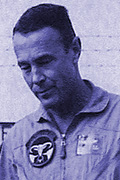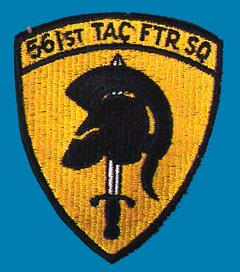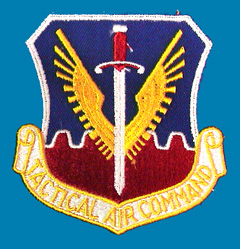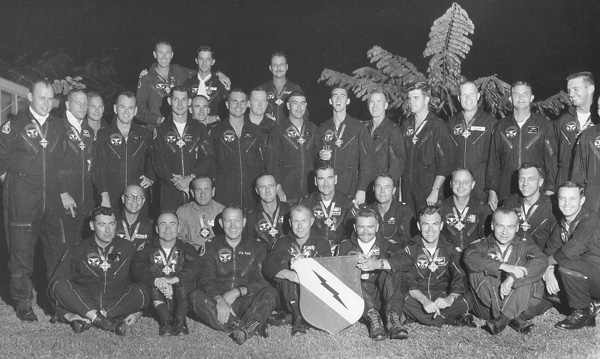Chapter 5 >
Autobiography home >
NF-104 home

|
|
|
Chapter 2 Aerial Combat |
|
Chapter 3 Flight Test |
| Chapter
4 Approach to Space |
|
Chapter 5 Limited Weapons, Assured Defeat! |
|
Chapter 6 Limited War: Unlimited Sacrifices & Defeat t/c |
|
Chapter 7 End of the Beginning t/c |
|
Chapter 5 - Limited Weapons, Assured Defeat click on the links below for more of the story... i. Limited Feedback - ii. Back to School - iii. 388 Tactical Fighter Wing - iv. Rolling Thunder - v. Rules by Fools - vi. The Bridge - vii. Good Morning Vietnam! - viii. Home Again |
||||
Back to School561st Tactical Fighter Squadron, McConnell AFB, Wichita KS, Mar thru Jun 1997
It was fortuitous that the F-105 was the only century series fighter I had not flown. If I had already flown it, I expect that my lack of experience in dive-bombing would have been overlooked in light of my fighter background and I would have arrived in combat as a less effective pilot. I was sent to McConnell AFB for checkout and tactical training, including weapons delivery, aerial refueling, etc. I knew that gaining skill in dive-bombing needed to be first order of importance. I had the vital and difficult parameter of dive angle wired from my Eglin days and was practiced in visualization, which served especially well in preparing for difficult and complex flight tests, where there is not opportunity for practice, except in your mind. Dive-bombing was what I concentrated on, although I did hit the one air-to-air (dart) target on my first pass, which I should with my past in that facet of combat. I didn’t expect to be doing low angle strafe, but it is least difficult and I had learned it as a new pilot. As I expected dive-bombing was where the rubber met the road in Vietnam. It would become the be-all and end-all of our success or failure, and there was never chance to practice!
I would awake late at night when the quiet and dark were excellent for ‘making repetitive dive runs’. Pretty soon I could visualize the runs, end to end, with corrections for presumed contingencies. Before school was out, I was an outstanding bomber and I had established the lowest 4-bomb, average miss distance (CEP). Nothing else in all my flying experience satisfied me more or served me better than that in Vietnam. During training, we had a rule that pullout from runs had to be completed by a minimum altitude. This had no bearing on our accuracy because we had a release altitude of 4000 feet, as I recall. I used release altitude faithfully, which must always be adjusted for accuracy control as release parameters vary on every pass. I never was one to pull-up too quickly after bomb release for fear of misguiding it, even in combat, so I once broke the ceiling established and was reported. I was directed to go to the tower and pull a ‘punishment tour”. I expected to have some of the trainees as my wingmen in combat and wasn’t about to leave that memory in legacy. I refused, was sent to the Wing Commander, apologized and explained my rationale for refusal but stated my determination to take court-martial, if necessary. I definitely would have seen that out to the end. The colonel understood my predicament, complemented my training record and dismissed the issue. I also had the opportunity to spend quality time with some great guys with whom I would fly in Vietnam. Among them, I met three students and new friends who would fly their tour in my squadron. They were Col. John Flynn, Maj. Spence “Sam” Armstrong and Maj. Donald Hodge. Spence became my Operations Officer, Don a Flight Commander, and all three of us proudly served and flew with John Flynn, as our Wing, Vice Commander. There were 18 of us from all walks of Air Force Life. Bill Reed a fine man was among those that ended up in Korat, along with Ed Deck, Cal Diehl and Bob Grubb Bob stood out for the courage or just plain raw guts to move from a life on the right side of a B-52 cockpit and volunteered to join us. He was not only long in guts but raw talent at the beginning. I remember seeing him latch on for his first air-to-air refueling and go into a J.C. maneuver, so violent yet he reacted so fast that he stayed attached with the nose hardly moving on his bird but the tail on a huge up and down excursion and I might mention his head was more nearly keeping up with the oscillating tail than the nose. If he were not strapped in he would have done the first ejection through the canopy, without firing a charge. They went on to perform very well and bravely in combat, which was predictable in training. Another event that brought us together was survival school, and its hardships, most notably the simulated POW camp experience, where force and pain were combined with psychological pressure by expert and realistic captors, even with foreign accents for effect, after a week of grueling evasion had sapped strength and will. The instructions we received for the Korean War of telling the enemy anything to avoid torture except detrimental to fellow POWs, had been replaced by hold on as long as possible and then give up as little as necessary, if captured in Vietnam. This was excellent training to prepare for that eventuality. Due to winter we evaded in snow of the mountains of Oregon, not very appropriate for NVN, but very effective in sapping strength when being tracked at the risk of starting all over from the beginning, if ever captured. Ultimately we were placed in a position of certain capture, with the unreal prospects of evading to a safe house, through heavily guarded areas, to sap the last vestiges of endurance and strength before capture and incarceration. They added the last measure of physical stress crawling through concertina wire barricades before inevitable capture, and the P.O.W. experience that followed was made very real, physically and emotionally.
We graduated, said our goodbyes to families and were headed to the combat zone as our trip to Thailand was recalled by Major Spence “Sam” Armstrong: “Bob Smith, Don Hodge and I boarded a Continental Air Lines DC-8 at Travis Air Force Base in California. We stopped at Hickam Air Force Base in Hawaii for fuel then endured the long haul to Clark Air Base in the Philippines. We stayed there for almost a week to undergo Jungle Survival School. After a brief classroom session, we were taken out on the survival trek with our classmates from McConnell, into the jungle. A highlight of the course was the demonstrations we got from the Negritos. They were a group of natives of the aboriginal type. They lived in the jungle and kept themselves separate from the Phillipinos except to act as guards around their compounds. The Negritos were small but expert hunters and fighters who were greatly feared by the Phillipinos. We had one exercise where we were told to hide in the jungle to see if they could find us. They did in short order. Another thing they did was to use some bamboo sections to cook taro roots, which they had harvested from the jungle. It was actually quite tasty! I’m not sure if the Negritos understood us or not as they never spoke a word that we could understand. We all commented that it was too bad that we couldn’t take them with us on our missions because survival in the jungles of North Vietnam would be easy with their assistance.” My own favorite memory of jungle survival training, relates to our hide and seek, with the Negritos. Their reputation provided me with a great challenge to evade. We were told to stay out of the huge bamboo stands because of the deadly vipers that lived in them and were referred to as ‘two-steppers’, about how far you would move before dying, since the toxins were said to affect both the nerves and blood system. I rationalized my odds with the snakes with the prize in personal satisfaction of beating the “unbeatable” Negritos and eased deep within a huge, almost impenetrable stand of bamboo, trying so carefully to avoid tracks or disturb the bamboo. I figured that no matter how good the tracker, if I traveled deep enough in it I would get through some areas without trace. Satisfied, I then lay down in a ball to listen, for what seemed an eternity. I heard nothing, until startled by a tap on my shoulder and a strange voice, coming from a diminutive Negrito! I stopped doubting the tales of how fearful the Japanese occupiers of the Islands were of those little people who hated their enemies so much that they would sneak into their barracks at night and randomly slice throats, intentionally leaving survivors to awake and quake. While we were at Clark Air Base near Manila, Chuck and Glynnis Yeager invited me to dinner at their home on the base. Chuck was the Commander of a Composite Wing, which had both fighters and light bombers in its squadrons and which would go on temporary duty for special missions in the Vietnam Theater of Operations. It was an especially relaxing feeling of being at home in the States, a feeling I would not have again for a long time. Sam continues ....... “We took a military charter flight from Clark to Bangkok. We had one night in Bangkok in the Grand Hotel before we flew to our respective bases in upper Thailand—Takhli and Korat. The next day we were picked up with our belongings and taken out to the military airport there in Bangkok where we boarded a C-47, which dropped us off at our respective bases. We got out of the venerable “gooney bird” C-47 on the ramp at Korat where the F-105’s were parked. Someone was finishing his 100th mission that day and we witnessed the parade and celebration that ensued. The realization hit home—we had 100 missions before we could be in the same position as the lucky pilot who was headed home with honor! The day we arrived—1 October 1967—was the day that Korat went from 4 squadrons to three. This left the 34th and the 469th squadrons as the strike squadrons. Those two squadrons flew the single seat F-105D, which dropped bombs, and the designation of 44th squadron went to the new “Wild Weasel” squadron.” They put us up in temporary quarters until we were assigned to a squadron the next day. Bob, Don and I were assigned to the 34th. Now we could move into our squadron “hooches”. Each hooch had four rooms for two pilots each, a screened-in porch and a common bathroom. The rooms were air-conditioned and quite roomy for a combat tour! Plus, each hooch had a Thai girl assigned who cleaned, washed our clothes and shined our flying boots. Each flight had a pickup truck assigned to it so we had five of them for our squadron plus one for the squadron commander. These trucks were equipped with a canopied flatbed and seats along the side in back.
Everything was pretty standard to checking in at any new assignment until the sergeant asked me where I’d like to go on my follow-on assignment. I expressed surprise by saying: “I just got here”! He responded: “Well, if you make it through 100 missions, it takes about 6 months and that’s how much time we need to work your next assignment. It was the “if” that got my attention. That point would be quickly emphasized! |
| previous section | next section |



.jpg)
